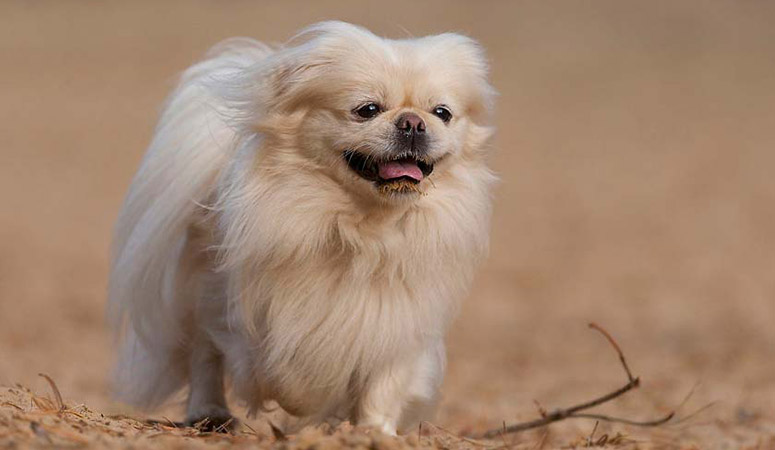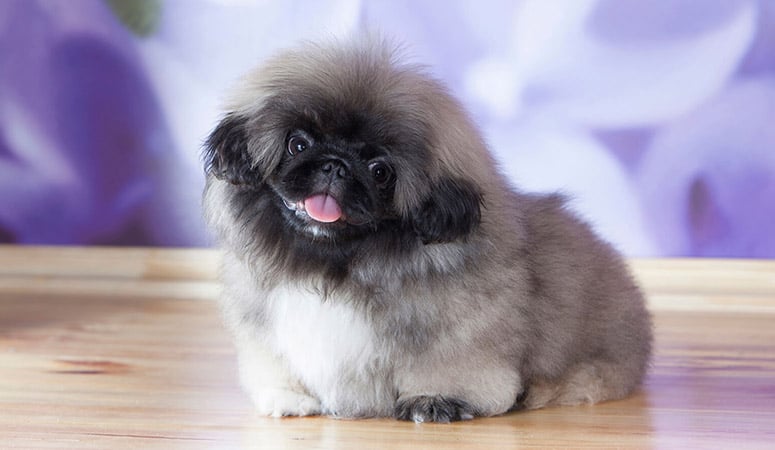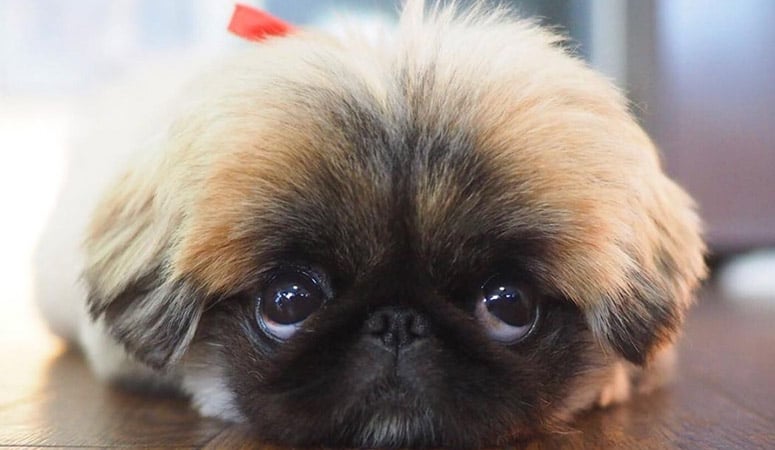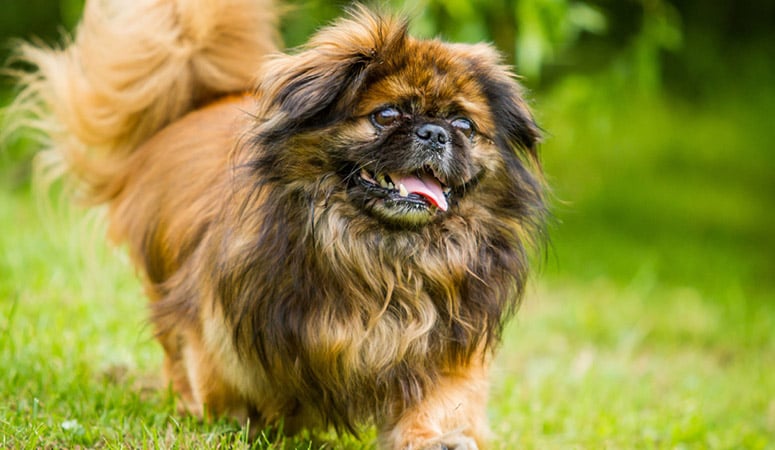Pekingese
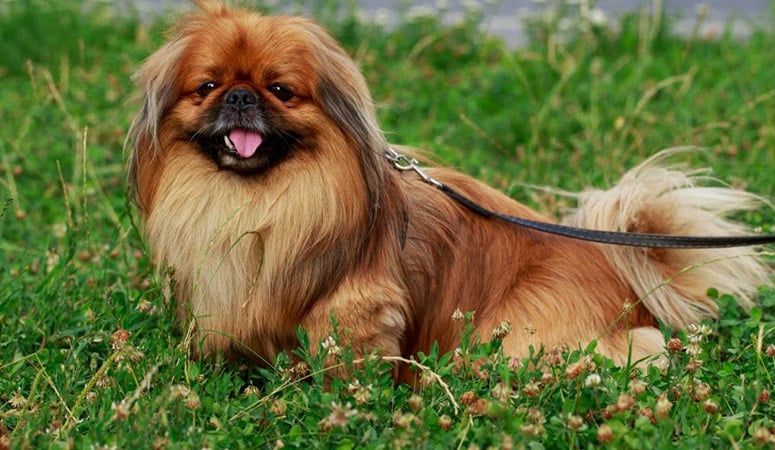
Here comes a Pekingese with a regal disposition and elegant gesture. His long coat can bring not only warmth but noble appearance. Ancient Chinese emperor own them in palace, as Pekes can be affectionate and have deep connectiona with their owners, quiet most of the time.
| Other Names | Lion Dog, Peek, Peke, Sleeve Dog, Sun Dog |
| Color | Black, Black and Tan, Brown, Gray, Red, White |
| Height | Males: 6-12 inches. Females: 6-12 inches. |
| Weight | Males: 7-14 pounds. Females: 6-14 pounds. |
| Life Span | 12-14 years |
| Personality | Affectionate, Loyal, Regal in Manner |
| Exercise | Normally Calm |
| Origin |
| Popularity | #83 |
| Groom Needs | 2-3 Times a Week Brushing/Seasonal Shedding |
| Kids Friendly | No |
| Dog Friendly | Yes with supervision |
| Watch Dog | |
| Family Dog | |
| Litter Size | 3-5 puppies |
Pekingese Pictures
Pekingese Video
Introduction
The fur around the neck and shoulder of a Pekingese is usually longer than elsewhere on its body. This is, perhaps, a plausible reason to attach to the Chinese mythology which claims that this breed of dogs was bred from lions. The Pekes, as they are fondly called, are compact dogs, their low-set bodies being well-muscled. They come in a variety of coat colors, but gold, red and sable varieties are more common.
A standard Pekingese is a small-sized dog, capable of standing at a shoulder height of between 6 and 9 inches. They weigh about 13-14 pounds, regardless the gender. Pekingese dogs are very loyal and have a lovable nature. Gentle and elegant, perhaps an adaptation of their royal ancestry. They have an average lifespan of 11-14 years.
Living with Pekingese
To keep Pekingese tidy, owners need to brush their coats regularly. A small bristle brush can be applicable to both Pekingese puppies and seniors. If owners groom them carefully every time, tangles and mats will hardly exist. Brushing needs some techniques instead of brute force. Firstly, spray some water or conditioning spray to avoid a loss of hair during grooming. Secondly, remove dead hair to a maximum by brushing hair near skin with a comb. Clean ears regularly to avoid wax buildup, irritation or infection. Cotton swab is not recommended, as cotton swab can never replace veterinarian-approved cleanser which is more sanitary. Teeth should be brushed once a week, as gum health is important. And bad breath will bring owners a sense of resistance. Have nails trimmed monthly.
Sedate most of the time, Pekingese actually requires some moderate exercise. Owners can take them out for a brisk walk. Regular walks can do good to Pekes. Owners should ensure the daily exercise needs of Pekes. But overexercise problems is not appropriate, but Pekingese are intelligent as they will exercise at their own pace. Owners can choose to take them outdoor for more fresh air and open area. Twice a day is suitable for Pekingese to digest what they’ve eaten. Two-hour walks for each time will keep Pekingese in good health, adding more owner-pet interactions and emotional connections. Take them out to run with other dogs in the lawn can help not only physical health but mental health.
As Pekingese are adorable and small, the food-begging is hardly refusable. Owners might directly feed them with food which is nearby, ignoring the suitability of food. The amount of food should be suitable for their age, size and weight. Small diet is enough for them. And owners should pay attention that not all human food is applicable to small dogs. Owners may prepare some high-quality and healthy dog food with enough vitamins, carbohydrates, etc. Either commercially manufactured or home-prepared is suitable for pekes as long as foods are approved by veterinarian. Owners may need to concern about your dog’s calorie consumption and weight level, as they are prone to get overweight. Feed them with fresh and clean water will lead to good health.
It’s likely to miss natural barrier to protect eyes for short-faced breeds with small size nose. So Pekingese with moderate-sized muzzle can be perfect for dog feeders to choose. Offer a healthy and safe environment for Pekes. Cool temperatures will bring Pekes pleasures. You can get them with cool pad when summer is upcoming. Basical grooming, ears protections, teeth brushing are also neccessary for Pekingese. As infections, irritations or wax build up will make bacteria gradually appear. Potential health issues might appear such as brachycephalic upper airway syndrome, degenerative heart valve disease, patellar luxation, pododermatitis. Health testing is of great importance as owners can decide the breeding plans in advance. It’s a good way to decrease the likelihood of disease in their puppies.
Total Annual Cost: $2133
Cost is estimated for the first year and may vary depending on many factors, such as dog food, health care, leash, collar, licensing, possible fencing, crates, training and obedience classes, dog-walking, grooming, treats, toys, flea, tick, and heart-worm meds, microchips, etc.
Friendly as he is, Peke is normally easy to get trained. This breed have lived in palaces for centuries. Pekes gradually form calm personality as their owners who are actually emperors often sit all day long in a quiet palace. You can train them by teaching them to react when listening a specified instruction. As they have strong connections to human and smart enough, they can be quick-learners. Owners should avoid anything that might attract dogs’ attentions during training. Training can be easy if there’s a tight emotional connection between Pekingese and owners. Hardly have kids play with Pekingese if owners plan to train them. As Pekingese might tolerate naughty kids, but they will gradually form impatience during the roughhouse.
History
The Pekingese was named for its supposed origin from the Chinese province of Peking, which is currently known as Beijing. Its history dates back to centuries beyond the Common Era, and we’ll possibly never know about their pedigree completely. Some believe that the earliest records of Pekingese’s existence can be linked to the 8th century C.E. Ancient Chinese myth claims that the Peke was a lion breed before Buddha bred it down to dog size. About that, we aren’t certain, although what’s clear is that the Pekingese breed had certainly been bred down from a larger dog but by the hands of Chinese nobility.
From early times, the Pekingese was a royal breed, not acceptable as a companion to the common people. In fact, it was considered a criminal offense to even try to steal a Peke dog. Such acts were punishable by death. The Pekingese, like its cousins –the Pug and the Shih Tzu– are considered the oldest Chinese breed, and they were bred to be flat-faced, perhaps to noble preference.
It wasn’t until the 1800s that the Pekingese came under the public spotlight, as initially they were relegated to palace courtyards. There was a British Invasion of Peking in 1860, which was to be known as the Second Opium War. In the rising tensions during the war, the Chinese royals sought a way to keep their sacred Pekingese dogs from getting into the hands of the marauders. In that bid, they ordered the killing of all dogs in the Chinese Imperial Palace. History tells us that the Emperor deserted his palace after that, and when the British troops arrived to loot and burn down the palace, they found his aunt and her five Pekingese dogs. She had committed suicide before they arrived.
The British later took these dogs to England, and they were redistributed to royals as gifts. Queen Victoria received a Pekingese at that time. The Pekingese breed arrived in America in the 1890s and was registered by the American Kennel Club in 1906.
Helpful Information
Breed Club: THE PEKINGESE CLUB OF AMERICA
Breed Club Link: https://pekingeseclubofamerica.com/
Breed Club Rescue: PEKINGESE CHARITABLE FOUNDATION
Breed Club Rescue Link: https://pekingesecharitablefoundation.org/

